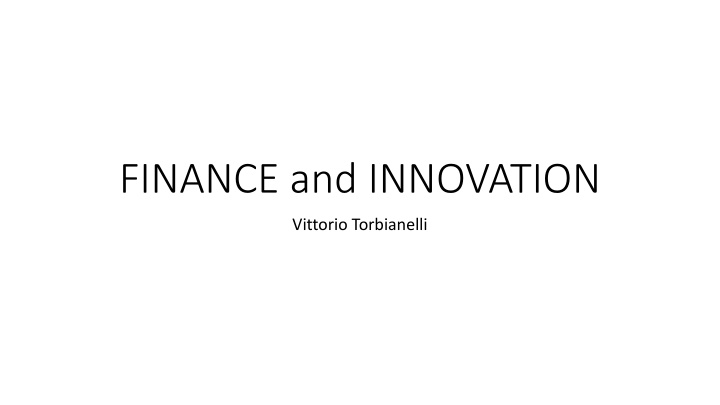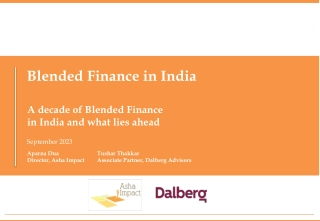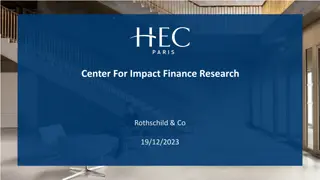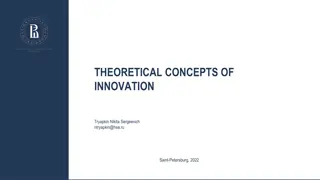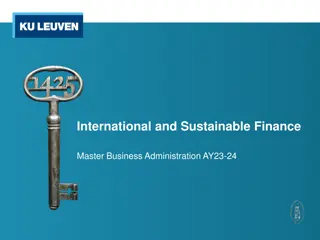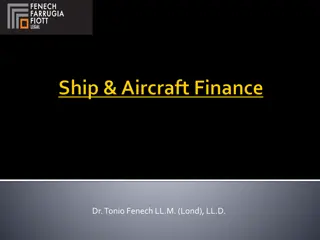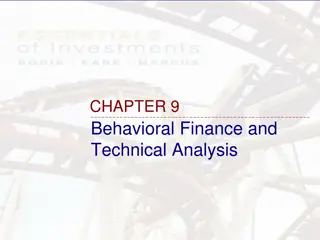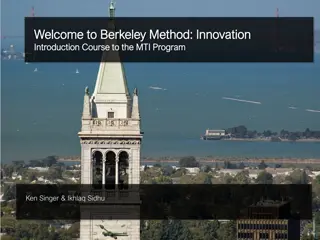FINANCE and INNOVATION
the intersection of finance and innovation, emphasizing resource allocation and its implications for organizational learning and investment characteristics. Delve into the neglected issues and key concepts of Shumpeter's theories on credit creation, self-financing, and economic change. Understand the role of different industry sectors in innovation activities and the heterogeneous nature of resource allocation. Discover how entrants access resources and compete with incumbents in various ways, shaping the dynamics of innovation. Uncover the complexities of innovation-driven investments across different stages and industries."
Download Presentation

Please find below an Image/Link to download the presentation.
The content on the website is provided AS IS for your information and personal use only. It may not be sold, licensed, or shared on other websites without obtaining consent from the author.If you encounter any issues during the download, it is possible that the publisher has removed the file from their server.
You are allowed to download the files provided on this website for personal or commercial use, subject to the condition that they are used lawfully. All files are the property of their respective owners.
The content on the website is provided AS IS for your information and personal use only. It may not be sold, licensed, or shared on other websites without obtaining consent from the author.
E N D
Presentation Transcript
FINANCE and INNOVATION Vittorio Torbianelli
Key words Innovation and resources (it is an expensive process) Uncertainess Resource allocation Relationship beteween finance and innovation = implication of innovative activity for resource allocation Neglected issue!
Shumpeter and the innovation/finance issue 1. Enterpreneurial behaviour and resource allocation (micro) Credit creation (I period) vs self-financing (II period) 1. Structural economic change and resource allocation (macro) Key role of banking system in key structural economic changes and venture creation (cycles)
Shumpeter and finance microecnomics Shumpeter I Focus on credit creation small ventures the man Creation of resources ex-nihilo (commercial bank = the ephor of the exchange economy ) Shumpeter II Focus on self financing (from innovative investment) large company, the team Internal finance for facilitating innovative investment However the issue is still underresearched
Innovation, resources and organizational learning in firms How resources allocation doas allow organizational learning ? decision about scale of investment (who are key decisiomakers? On what basis decision is taken? what knowledge needed?) aquiring complementary assets to commercialize innovation What resources in different companies ? (cross industry variation in type of innovaton activities) Resource allocation is however a neglected issue!
FINANCE.and CHARACTERISTICS OF THE INVESTMENT CHARACTERISTICS OF THE INVESTING FIRM
Heterogenity(from innovation to finance) Sectoral differences in innovation activty : important implication for resources allocation!) E.g. when entrants dominate innovative activity: how do they get access to r.? - pure new entrants? Spin-offs? Diversification (from other industries)? Different competitive interactions (entrants vs incumbents) Direct competition? Licensing? Joint-ventures? Relationships with government (training?), universities (or public science?), customers, etc. Stages Innovation dominated by entrants or incumbents (e.g. car industry today) ? = Differences in type and amount of investment needed! (different costs of innovating )
In summary Heavy differences in.. Characteristics of enterprise requiring finance Sources of finances on whch they rely Implication of financial arrangement for innovation Two-way relationships ? e.g. Incumbents dominanting entrants: are incumbents more innovative or entrants too financially constrained? Entrants dominating incunbents: are they more innovative or are allowed by availability of f.r? Case Study.: Capital market Myopia - Hard disk drive industry ( 80) with many failures. Example of over-investment in venture capital? (short term but survivors in long term perspective?)
Techno-Economic Paradigms and finance Clusters of radical innovation (intepretative frameworks) Business cycles (Shumpeter) National Systems of innovation Carlota Perez (2002) Technological revolution and financial capital relationships between the financial and productive sectors alters as the eonomy moves from one stage of the life cycle to another What is exactly the role of finance in funding tech.revolution. Stock markets: transition periods (from founding/ incorporation /first product to listing) change across time
Financial economics and innovation Corporate finance and investment Literature on economic growth; endogenous growth theory focuses on: Characteristics and importance of venture capital Financing R&D intensive firms Finance economists have limits in understanding the finance/innovaton relationship? Traditional approaches: Cost benefit of different f. sources (Modigliani Miller, 1958); Focus on information asymetry ( 70)
Focus on the venture capitalist asymmetric information as the foundation for a theory of venture finance (Sahlman) How the venture capitalist overcomes the problem of financing ventures in the presence of asymmetric information Further research on the capitalist/company relationship: Staging/compensation/monitoring and control of investee company
Venture Capital (v.c.) in USA 1946. Boston. American Research and Development (ARD), founded by local ivestment community (+ MIT) Link and funds - with MIT 1957 Digital Equipment Corporation (1957) huge success/interest! A new breed of financiers has emerged out of Sylicon Valley E.g. Starchild : Reinvesting capital in promising startups + cash, technical and managerial skill, operating experiences, network of contacts (co- investors), advising, etc. 80/ 90 further expansion; regulatory changes (reduction of capital gains taxes from 49% to 20%; promoting investment by pension funds;
Venture capital in USA (2) Considerable volatility (boom-bust cycles 60, 80, late 90/ 00) High concentration by sector 60- 90: office/computing m.; commun./electronics; pharma; scientific Instruments (= 81% of all USA v.c. investment) with differences across time EU: v.c. growth 1989-99 (from 0,04 to 0,12 of GDP) Italy: 0,02-0,05; Sweden; 0,02-0,19
Internal vs external finance Asymmetric information: do internal resources (liquidity) cost less than external ones? Some empirical evidence: liquidity matters!...but but characteristics of enterprise investment might influence finance! stage of developmentmight matter too R&D and finance (info asymmetries between financers and managers) Cost gap between internal and external finance is greater than other investments (more internal funds) Imperfection in capital markets might have more effect on R&D (and in general on high tech industries?) than other investment Cash flow positively correlated with R&D expenditure..(but )
Firm and financial behaviour (do) the charateristics of investing firm matter to the financial behaviour (?) Financing growth cycle theory. E.g. Early stages = difficulties rasing external finance (asimmetryc info, etc.) but but empirical reaserch shows: funds provided by the owner are more important as the firm gets older; finance from insiders never outweights finance provided by outsiders (also for the youngest companies). TBSFs do not have more difficulties thn SMEs in general (UK)
Economic Growth Might the development and structure of a country financial system have implication for its economic growth? Recent articles focus on the mechanism Neoclassical theory doas not differentiate among sectors (aggregate economica activity) some scholars differentiated among industries (they have different finance requirements in different stages Thus relationship with external finance is not the same) Rajan and Zingales (disaggregated approach): some industries need a developed financial system, in the country; other ones do not. (influences on specific sectors). Variations across countries in composition of economic growth
Research agenda on finance and innovation Good case for further integrating theory and empirical evidence Limits of the dominant approach (financial economics) role of historical processes Lmits of versatility of the asimmetries of information device are there differences between R&D investments of a pharma firm and a new automobile plant? uncertainty is more relevant than asimmetries of information! No objective guidelines for making decisions Different states of the world are possible and new information might be unuseful..
Limits of the neoclassical financial economics approach A rather limited and static concept of rationality is adopted Subjective and experential dimension are excluded no attention payed to the firm as an organization (not only markets ) No allowance for variations and changes in istitutional context Only focus on price and quantity of finance provided Suggestion to embrace a conception of technology that is historically- contingent and institutionally specific Who gets financial resources; when they get them; how they use them; - qualitative distinctions among firms/periods/investments/contexts
